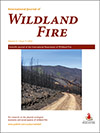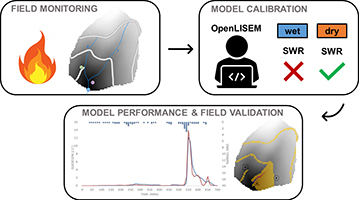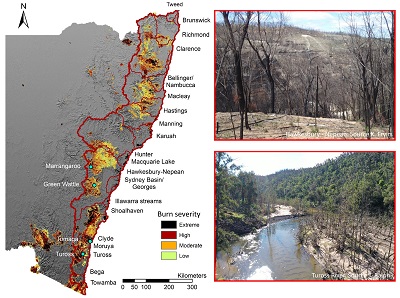
International Journal of Wildland Fire
Volume 31 Number 7 2022
Construction and landscaping professionals are generally not required to obtain credentials indicating their competency in mitigating the risk of structural damage in a wildfire. We discuss implications of this policy gap and propose a solution to bolster competency of professionals in wildfire protection as communities further expand in fire-prone areas.
WF22012 Abstract | WF22012 Full Text | WF22012PDF (783 KB) Open Access Article
Wildfires and heatwaves in summer are connected. Our results concerning the Iberian Peninsula show that together with more extreme heat events observed in the region, an increase in burned area was also found in the month of June, while a prominent decrease in such events was found in September.
WF21155 Abstract | WF21155 Full Text | WF21155PDF (9.2 MB) | WF21155Supplementary Material (434 KB) Open Access Article
WF21005Event-based quickflow simulation with OpenLISEM in a burned Mediterranean forest catchment

Recently burnt areas tend to produce strong runoff responses but predicting such responses still poses a major challenge. Here, the runoff predictions of OpenLISEM were assessed for a completely burnt 10 ha-catchment. Optimised model inputs varied markedly between the 16 runoff events, with initial moisture conditions being of limited relevance.
WF21005 Abstract | WF21005 Full Text | WF21005PDF (3.3 MB) | WF21005Supplementary Material (3 MB) Open Access Article
WF21110Fire scar characteristics in two tropical montane conifer species from central Mexico
Buried fire scars are common in thick-barked Abies religiosa and Pinus pseudostrobus fire-scarred trees. The oldest, largest trees do not necessarily contain more fire scars, and the absence of visible scars does not imply the absence of fire. These findings will facilitate future dendroecological research in tropical montane conifer species.
WF21110 Abstract | WF21110 Full Text | WF21110PDF (2.9 MB) | WF21110Supplementary Material (31 KB) Open Access Article
Fuel has been measured for the first time in Austrian coniferous forests. We found considerable difference in fuel by region and forest type, with low-productivity forests having the least fuel. Dense forests have more dead needles and woody fuel, but less herbs and grass, compared with open-canopy forests.
WF21161 Abstract | WF21161 Full Text | WF21161PDF (3.2 MB) | WF21161Supplementary Material (698 KB) Open Access Article
WF21092Predicting the fine fuel moisture content in Dalmatian black pine needle litter
Laboratory measurements of equilibrium moisture content and response time of dead black pine needles were used to modify the Canadian hourly fine fuel moisture code. Incorporating species-specific data increases the accuracy of fine fuel moisture content prediction, which is a key parameter in many fire behaviour and danger rating systems.
WF22046Rivers up in smoke: impacts of Australia’s 2019–2020 megafires on riparian systems

Fifty percent of all riparian vegetation along 29 394 km of stream in coastal catchments of NSW, Australia, was burned in the 2019–2020 summer with 29% experiencing extreme or high-severity burns. Novel ecosystems have likely been created, requiring a new approach to riparian vegetation management to prepare for future catastrophic fires.
WF22046 Abstract | WF22046 Full Text | WF22046PDF (13.6 MB) | WF22046Supplementary Material (736 KB) Open Access Article
A variety of fire weather indices have been developed and employed in different contexts ranging from fire behaviour prediction and understanding wildfire potential to identifying conditions conducive to blow-up fires. This paper considers four such indices and proves that they are essentially equivalent measures of fire weather.




